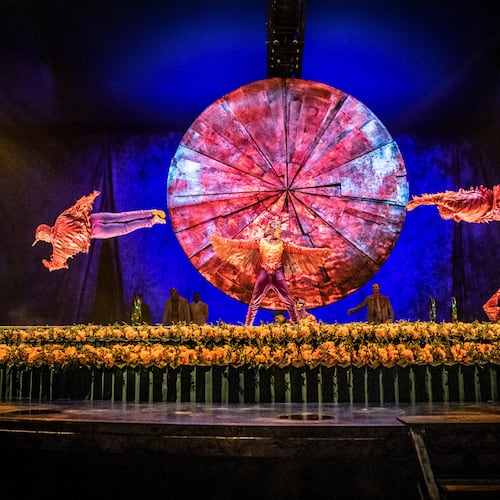In the late 1830s, thousands of Cherokee and other native tribespeople were forced from their ancestral homes in Georgia and the Southeastern United States and resettled in unknown territory west of the Mississippi in what has come to be known as the Trail of Tears. It was a disaster for the Cherokee and a blot on the history of the young United States.
In his accessible history narrative “Blood Moon,” author John Sedgwick pulls no punches in depicting the Cherokees’ forced migration, and the book’s accounts of displacement, dispossession and disease make wrenching reading. Beginning on May 23, 1838, thousands of U.S. troops drove families from their homes without warning: “When youngsters fled in terror into the woods, parents were not allowed to collect them, leaving them to grow up alone in the wild, if they lived at all, while their elders were sent to the Indian Territory in Oklahoma.”
But “Blood Moon” places the tragic event in a context that’s more complex than many readers may realize, revealing how internal divisions within the Cherokee Nation may have made a bad situation worse. As the book’s subtitle, “An American Epic of War and Splendor in the Cherokee Nation,” suggests, “Blood Moon” unfolds as a sweeping intergenerational saga that views the devastation of a people from the perspective of two families.
Two extraordinary individuals provide the axis on which the story turns. One is named “The Ridge,” for “He Who Walks on Mountains” in Cherokee, and later called Major Ridge. Born in 1771, he was raised in the tribe’s demanding, at times violent traditions to become a towering figure. The Ridge was a formidable warrior, leader of men, wealthy landowner and, perhaps unexpectedly, a supporter of Cherokee cooperation with U.S. policies, seeing the loss of their home as unavoidable.
While he spoke no English, John Ross (born in 1790) spoke no Cherokee, and was in many other ways The Ridge’s opposite: a diminutive trader and born politician who emphasized the Scottish side of his mixed heritage. Yet Ross commanded the support of the Cherokee’s full-blooded majority so completely that he served as the nation’s primary chief for nearly four decades.
For a time, Ridge and Ross were allies, and both served under Gen. Andrew Jackson in the Creek Civil War, The Ridge as a veteran officer, Ross as a young adjutant. But as the decades passed, their rivalry became so deep, turning on irreconcilable ideas about Cherokee identity, it would extend to outright assassination attempts and draw in their sons and extended families.
“Blood Moon” proves best at dramatizing and exploring conflicts, including the political ones. Sedgwick lays out how the U.S. expansionist policies and Georgia gold rush fever put the Cherokee in an inescapable predicament: “(U.S. President Andrew) Jackson’s implacable demand for removal was heartless, and Georgia’s straight-out land theft by means of a lottery was criminal, but the Cherokee Nation was in no position to resist either one.”
Fatalistically, The Ridge argues that resettlement under negotiated terms would be better than nothing, making him head of the tribe’s relatively modest “Treaty Party.” Ross shrugs off such attempts as compromise, assuring his followers that all will be fine if they stay put, and thus leaving them unprepared for the removal date. “Blood Moon” implies that there’s blame to go around on most sides — the Treaty Party’s dealings with the Jackson administration, however justifiable, circumvent the wishes of the Cherokee majority. But Sedgwick’s sympathies clearly lie against Ross, who comes across as a shameless, corrupt opportunist who values his own interest over the nation.
Frequently the book’s conflicts erupt in violence, from two men with tomahawks to multiple armies on battlefields. A memorable scene from early in The Ridge’s life pits him against a bloodthirsty chief called Doublehead, whose grisly end proves reminiscent of the death of the notoriously resilient Rasputin. After removal, the tribal divisions play out with rival gangs and end up placing Cherokee soldiers on opposite sides of the U.S. Civil War.
As a century-spanning history book, “Blood Moon” is unusually fast-paced and compelling, at times reading more like one of Bernard Cornwell’s action-packed period novels rather than an academic tome. Sedgwick seems most vested when his accounts hinge on personalities or battles, but becomes less focused and authoritative when describing larger, less tangible socioeconomic forces.
The book offers more than broken treaties and other betrayals, with the story including a fascinating tangent on Sequoyah and his remarkable success at crafting a written version of the Cherokee language. Sedgwick also shares stories of star-crossed Cherokee males, including an aging John Ross, as they fall in love with young women from socially-conscious white families. Meanwhile, the Ridge’s son John grows up with feet in both worlds, and his balance of native American traditions with “white” society evokes the contemporary concept of racial code-switching.
But “Blood Moon” ultimately leaves its readers with a pervasive sense of loss at the wanton destruction of a way of life. The revelation that the Cherokee has grown to become the second-largest tribe in America (“with almost 300,000 people on its rolls”) serves as no consolation to the decades of bloodshed and suffering captured in the book. Few tragedies prove as readable.
NONFICTION
‘Blood Moon: An American Epic of War and Splendor in the Cherokee Nation’
By John Sedgwick
Simon & Schuster
487 pages, $30
About the Author
The Latest
Featured


